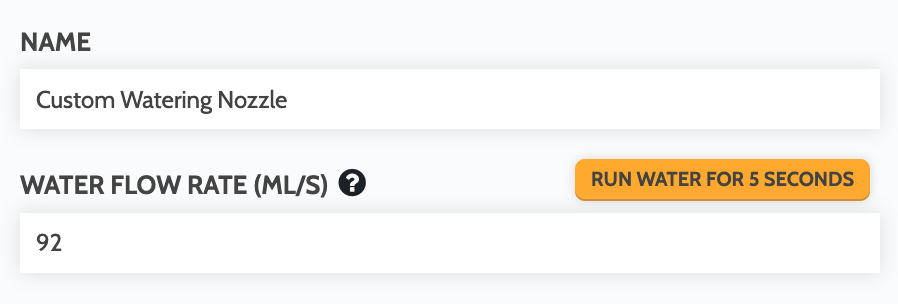Tools
List of tool Lua functions in FarmBot OS
dismount_tool()
Dismounts the currently mounted tool into it’s assigned slot, taking into account the slot’s direction.
This function only applies to FarmBots with interchangeable tools, such as FarmBot Genesis.
-- Dismount the currently mounted tool
dismount_tool()
-- It is recommended to find home after dismounting tools
-- to stage FarmBot for future operations
find_home()
dispense(mL, params?)
Dispenses the given amount of liquid in milliliters. Defaults to using the “Watering Nozzle” tool, its WATER FLOW RATE (ML/S) value, and the solenoid valve operated by pin 8.
-- Dispense 100 mL of water using default values
dispense(100)
The params argument is optional and can be used to override the default tool_name (and therefore the WATER FLOW RATE (ML/S) value) as well as which pin to operate.
-- Dispense 200 mL of fertilizer using a custom tool operated by pin 7
dispense(200, {tool_name = "Custom Watering Nozzle 2", pin = 7})
-- Dispense 300 mL of water with the standard "Watering Nozzle" tool, but using a solenoid valve operated by pin 10
dispense(300, {pin = 10})
In order to add a WATER FLOW RATE (ML/S) value to a tool, the tool name must contain “Watering Nozzle” in the name.

get_tool(params)
Get a tool by the given id or name. Returns a table with the tool’s id, name, and flow_rate_ml_per_s.
Note that the tool object does not include the coordinates of the slot that it is assigned to.
-- Get a tool by its ID
tool = get_tool({id = 123})
toast(tool.name)
-- Get a tool by its name
tool = get_tool({name = "Watering Nozzle"})
toast(tool.flow_rate_ml_per_s)
mount_tool(tool)
Mounts the given tool and pulls it out of its slot, taking into account the slot’s direction.
This function only applies to FarmBots with interchangeable tools, such as FarmBot Genesis.
-- It is recommended to find home before mounting tools
-- to ensure accuracy of movements
find_home()
-- Add a Location variable named "Tool" to the sequence
-- and select the tool you wish to mount
tool = variable("Tool")
-- Because tools themselves do not have coordinates, FarmBot
-- will look up which slot the chosen tool has been assigned
-- to and use the slot's coordinates in the mount_tool() function
mount_tool(tool)
You may also simply mount a tool by its name:
-- Mount a tool by name
mount_tool("My Tool")
verify_tool()
Verifies if a tool is mounted to the UTM by checking the UTM’s tool verification pin as well as the MOUNTED TOOL field in FarmBot’s state tree. Returns true if a tool is mounted or false if no tool is mounted.
This function only applies to FarmBots with interchangeable tools, such as FarmBot Genesis.
The verify_tool() functionality is built-in to the mount_tool() and dismount_tool() helpers.
-- Exit sequence if tool verification fails (no tool)
if not verify_tool() then
return
end
water(plant, params?)
Moves to and waters the given plant based on its age and assigned watering curve.
A plant’s age is calculated from its planted_at date and the current date. If a plant’s planted_at date is not set, try changing the plant’s STATUS to Planted from the frontend.
If using a FarmBot with interchangeable tools, such as FarmBot Genesis, you will need to first mount the watering tool before using the water() function.
-- Get the "Plant" variable from the sequence
plant = variable("Plant")
-- Water the plant based on its age and watering curve
water(plant)
Under the hood, the water() function makes a call to dispense(). If provided, the params argument will be passed into the dispense call to override its default values. See the dispense() docs for more information.
-- Get the "Plant" variable from the sequence
plant = variable("Plant")
-- Water the plant based on its age and watering curve, using a solenoid valve operated by pin 10
water(plant, {pin = 10})